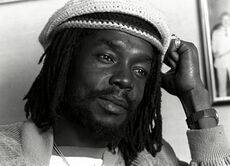Estranova
This article is incomplete because it is pending further input from participants, or it is a work-in-progress by one author. Please comment on this article's talk page to share your input, comments and questions. Note: To contribute to this article, you may need to seek help from the author(s) of this page. |
| Estranova | |
|---|---|
 Gervásio Cordeira, active in the 1960s and 1970s, was one of estranova's pioneers and well-known artists | |
| Stylistic origins | |
| Cultural origins | Early 1960s Porto Leste, Maracao |
| Typical instruments | |
| Subgenres | |
| Fusion genres | |
Estranova (/'ɛstrɑːnoʊvɑː/) is a genre of traditional music that originated in Maracao, specifically its capital Porto Leste, in the early 1960s. Its name is derived as a portmanteau of the words estranha, meaning "strange", and nova, meaning "new". Traditionally, estranova has placed emphasis on traditional instrumentation for its creation, but branched out as a broad and creative genre in the late 20th century, incorporating styles of rock and disco. More recently, estranova has been used as a catch-all term for Musica popular maracense, a broader subgenre of estranova, as well as music created and influenced by the worldwide Maracan diaspora. It is Maracao's most widespread and popular genre, and is promoted domestically through government ministries, organisations and state-sanctioned music labels.
It incorporates a range of instruments, but began as a utilisation of Auratian and Iustian instruments, including instruments both native to Euclea and those created and refined in Maracao. Instruments such as the cavaquinho, cuíca and violão maracense have been used by estranova artists since its origins in the urban scene of Porto Leste. The later introduction of the tamborim, piano, bass and flamenco guitars saw the genre refined over the 1960s and 70s, developing a unique style of play linked to the popular blues and folk acts and artists that garnered popularity throughout the Asterias during the era.
Estranova is a popular genre, and is by far Maracao's largest musical export by genre. Local iterations and scenes of the genre exist in Auratia, Belmonte, Chistovodia, Eldmark, Halland and Vinalia in the Asterias. Castelonovo is particularly recognised for its vibrant contributions to the genre, largely on the basis of common language between Belmonte and Maracao. It is also fairly popular in Bahia, where it is mainly characterised as a subgenre of Djeli pop, despite estranova's earlier origins. Many estranova artists have promoted musical connections to Bahia, and some have played live shows or toured in Bahia. Estranova is generally viewed as an apolitical genre, though political connections, mainly with socialism, have been espoused and blended into the music of several popular estranova artists over history.
History
Background and origins

Estranova can trace its roots to traditional music of Maracao present before the introduction of popular music at large. This music, much of which carried cultural connotations, such as ideology or religion, was centred mainly around traditional instrumentation centred around drumming and percussion. This stylistic tradition was carried over from Bahia and further developed by its diasporic communities in Maracao. The versatility of drums such as the karyenda proved pivotal in its cultural resurgence among its diasporic new world communities.
Alongside traditional Bahian instrumentation, estranova drew heavily from the niche development of musique concrète and record sampling. Crate diggers in Porto Leste often collected records for sampling in their music, splicing it over existing tapes to create new sounds that could carry a myriad of influences. One major influence was Belmontese samba, whose surge in popularity in the 1930s and 1940s made produced vinyls and records abundant, and were popular among early estranova pioneers such as Cordeira, who had amassed thousands of records over his musical career. Blues and jazz from elsewhere in the Asterias also saw representation in the greater style of estranova, especially in its earlier records produced in the early 1960s.